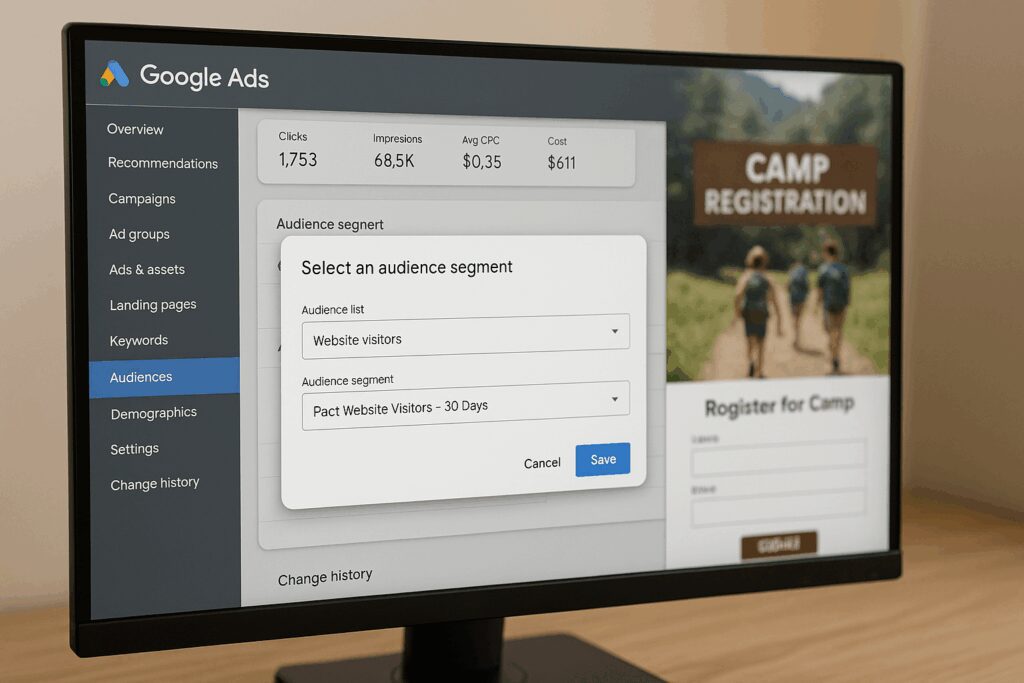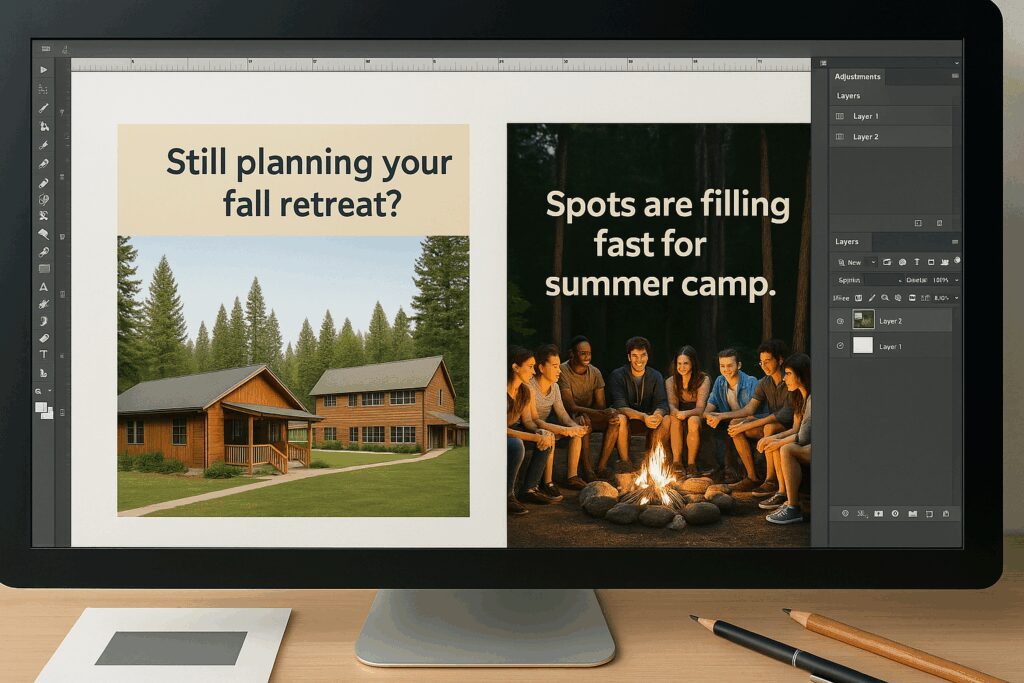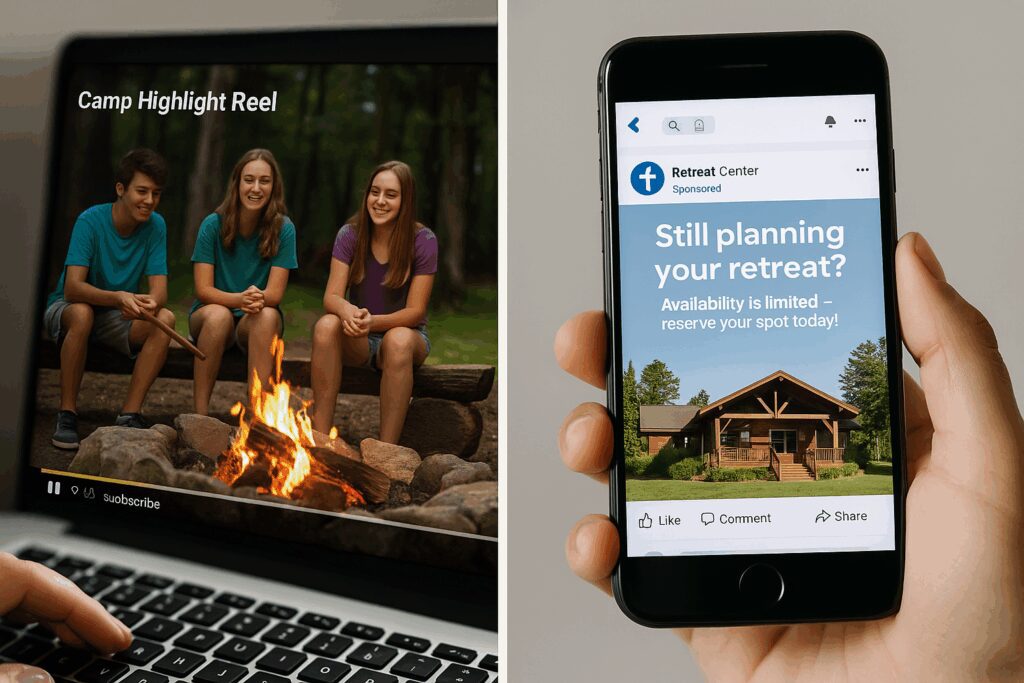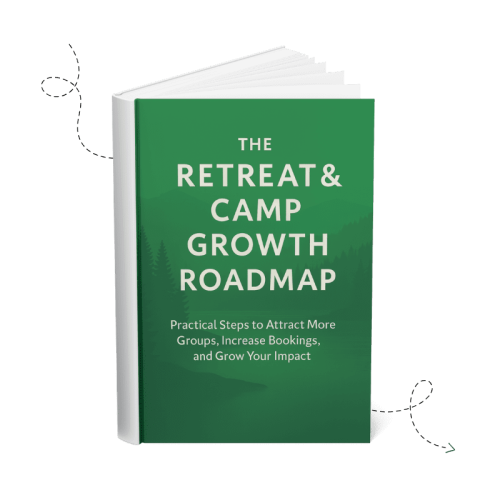Retreat & Camp Growth Roadmap Focus Area: Run Retargeting Ads
Introduction
Most group leaders and parents don’t book on their first visit to your website. They’re weighing options, comparing facilities, and sometimes just browsing while the real decision will happen later. Research shows it often takes multiple touches—sometimes seven or more—before someone feels ready to make a decision. Without a reminder along the way, many never come back—and your opportunity is lost.
Retargeting ads are designed to solve that problem. By showing tailored ads only to people who’ve already visited your site, you can gently stay in front of them during the decision-making process. For retreat centers and camps, this digital advertising strategy is one of the most effective ways to turn interest into inquiries and registrations.
Why This Focus Area Matters
Retargeting isn’t about chasing strangers—it’s about re-engaging people who have already expressed interest. Because you’re only speaking to warm audiences, every dollar works harder, which is good stewardship of limited marketing resources.
This focus area matters because:
- It supports mission clarity. You’re reaching groups and families already aligned with what you offer.
- It fits real decision-making cycles. Retreat leaders often take weeks or months to evaluate options. Parents often deliberate before registering children for camp.
- It builds trust over time. By reminding them of your space, your values, and your experiences, you become the obvious choice when they’re ready to act.
- It demonstrates stewardship. Instead of spending broadly on cold advertising, you’re investing wisely in people who already showed interest—honoring both your mission and your budget.
For ministries with limited budgets and staff, retargeting is a simple but powerful way to keep the right people engaged without wasting energy on broad advertising. In fact, it’s one of the most effective retreat center marketing strategies available today.
Is This an Area You Need to Focus on Right Now?
Ask yourself:
- Do many visitors browse your site without submitting an inquiry or registration?
- Do your bookings depend on leaders or parents who need weeks or months to decide?
- Have you noticed leads “going cold” after showing initial interest?
- Are you investing in ads but have no way to re-engage visitors who didn’t act right away?
If you answered “no” to any of these, this focus area can help you bring greater clarity, alignment, and impact to your outreach.
Putting This Focus Area into Practice
Define Your Retargeting Audience
Before you set up your campaigns, you need clarity on who you’re talking to. Defining your audience helps you reach the right people with the right reminders, instead of wasting effort on those who aren’t likely to book.
Start by deciding who you want to reach:
- All website visitors (good for general awareness).
- Visitors to specific pages (e.g., summer camp registration or retreat facilities).
- Past inquirers or attendees (people who’ve already shown strong interest).
Choose how long to keep people in your audience (known as an “audience duration window”). For retreats, a 30–90 day window works well since planners often take time to finalize. For camp parents, shorter windows—7 to 30 days—may align with registration deadlines. Think of it in terms of their real-world decision cycle.
Taking time to define your audience up front makes every dollar of retargeting more efficient. Once you know who you want to reach, the next step is making sure your creative and messaging connect.

Shape Your Creative & Messaging Strategy
Your ads won’t just work because they exist—they need to resonate. Strong visuals and thoughtful messaging remind people of the experience you provide in a way that feels helpful, not pushy.
- Use compelling visuals. Show cabins, meeting spaces, outdoor activities, or smiling campers.
- Keep messaging invitational. Think: “Still considering your fall retreat?” or “Spots are filling for summer camp.”
- Refresh regularly. Swap out images and copy every few weeks so your ads don’t feel repetitive.
Refreshing creative and keeping messages aligned with your audience’s needs makes retargeting feel natural. With strong visuals and clear reminders in place, it’s time to think about where to deliver those ads.

Choose the Right Platforms
Not all platforms are equal, and the right mix depends on where your audience spends their time. Choosing the right platforms ensures your reminders show up in spaces where leaders and parents are already engaged.
- Google Display Ads for Retreat Centers: Show image-based ads across a wide network of websites and apps. Ideal for keeping your retreat or camp visible in everyday browsing.
- YouTube via Google Ads: Use video retargeting to tell your story while prospects watch related content. A short testimonial or highlight reel can be especially effective.
- Facebook Ads for Camps and Retreat Centers (Meta Ads): Parents and group leaders spend a lot of time here. Retargeting ads on these platforms blend into their daily social media use and can provide gentle reminders.
- LinkedIn Ads: Especially useful for leadership retreats and professional groups, LinkedIn retargeting can keep your center in front of decision-makers in a work-related context.
By choosing the platforms that fit your audience, you maximize impact without spreading resources too thin. Once you know where you’ll run ads, the final step is following best practices to keep them effective.

Apply Best Practices
Every good campaign needs guardrails. Best practices protect your audience from fatigue and make sure your ads remain a welcome presence instead of a distraction.
- Control frequency. Limit how often someone sees your ad to avoid fatigue.
- Offer value. Share testimonials, upcoming events, or registration deadlines rather than pushing too hard.
- Track results. Measure return visits, inquiries, and bookings to understand what’s working.
When you apply these best practices, retargeting ads become a steady, gentle reminder instead of an annoyance. With these steps in place, you’re ready to organize your approach using the Run Retargeting Ads Worksheet.
Retargeting Ad Campaign Planning Worksheet
Running ads across multiple platforms can feel complex, but it doesn’t have to be. The Retargeting Ad Campaign Planning Worksheet simplifies the process by helping you:
- Map out your target audiences and time windows.
- Plan your creative and messaging for each segment.
- Align your campaigns with your retreat or camp’s decision-making cycles.
If retargeting sounds complicated, this worksheet is designed to reduce overwhelm. You don’t need to be a marketing expert—it walks you through defining your audience, message, and timing in plain language.
📥 Download the Retargeting Ad Campaign Planning Worksheet
Using this worksheet gives you a clear, step-by-step path so you don’t get lost in the details of campaign setup. It’s a tool to help you simplify choices and focus on what matters: reaching the right people at the right time with the right message. With that plan in hand, let’s consider how this plays out in a real-world example.
Mini Case Study
Refreshing Mountain Retreat Center provides a clear example of how retargeting can make an impact. They attract traffic from retreat planners to their website via channels like organic search, paid search, social media, and directory listings. While many visitors inquire right away, others leave without filling out a form. To address this, we helped them set up display retargeting campaigns via Google Ads, serving ads to prior website visitors who had viewed the retreat section in the past 6 months but hadn’t inquired. These campaigns kept their brand in front of retreat planners, brought many visitors back to the website, and ultimately led to an increase in overall retreat inquiries.
👉 Read the full case study: Refreshing Mountain Retreat Center
Resourcing and Managing Retargeting Campaigns
Knowing how retargeting works is only half the story—you also need to consider who will manage it. Many retreat centers and camps ask whether they have the time, tools, and expertise to run campaigns internally, or if they should partner with an agency.
The encouraging news is that retargeting can capture a layer of highly qualified leads who are far more likely to close, giving it one of the highest returns on investment of any advertising strategy. Even with a modest budget, campaigns can deliver meaningful results when run with the right strategy and accountability. That makes the investment worthwhile, even if you hire someone to help.
Working with an agency gives you access to deep expertise at a fraction of the cost of hiring staff. And if you choose an agency with experience in retreat center marketing and camp marketing, you also avoid the learning curve of someone who doesn’t understand your niche or your audience. The right partner can save you time, reduce frustration, and maximize your results.
With a clear understanding of both the strategy and the resources required, you’re well-positioned to decide how to move forward. Next, let’s recap the key takeaways and connect this focus area to the bigger picture of your growth plan.
Putting It All Together
Retargeting ads are one of the most effective ways to make the most of the interest you’re already generating. Instead of losing touch with potential guests, you can walk alongside them in their decision process—reminding them of the experiences you offer.
Key takeaways:
- Define audiences and duration windows carefully.
- Use creative that inspires and invites.
- Match platforms to where your audience spends time.
- Refresh ads often and avoid overexposure.
- Measure results and adjust based on inquiries and bookings.
Ready to Take the Next Step?
Retargeting keeps you in front of people who already know you. Once you’ve re-engaged those visitors, the next step is to Develop Organic Traffic—so you attract even more qualified visitors in the first place.
If you found this helpful, here are four great next steps to continue your journey:
🧭 Move to the Next Focus Area: Optimize Website Content
Learn how to attract new groups by optimizing your site content and improving visibility in search engines.
[Read Optimize Website Content Blog Article]
📘 Download the Retreat & Camp Growth Roadmap eBook
Get the full 3-stage system we use to help retreat centers and camps grow with clarity and purpose.
[Download the eBook]
🌱 Learn More About How We Help Retreat Centers & Camps
We’re a Christian-owned digital marketing agency that helps retreat centers and camps grow attendance, bookings, and impact through practical strategies rooted in clarity and stewardship.
[See How We Can Help]
🤝 Schedule a Free Discovery Call
Want help applying this to your unique situation? Let’s talk. We’ll explore where you are now, where you want to go, and how to take the next faithful step.
[Book a Discovery Call]
You don’t have to figure this out alone. Let’s build something meaningful—together.
Frequently Asked Questions
1. What’s the difference between retargeting and regular ads?
Regular ads target people who may have never heard of you. Retargeting specifically focuses on people who have already visited your site or interacted with your content, making it more efficient and effective.
2. How much should a retreat center or camp budget for retargeting?
Retargeting typically requires less budget than broader ad campaigns. Even $5–$10 per day can keep your center visible to warm leads, especially when combined with other marketing efforts.
3. Do retargeting ads annoy potential guests?
Not if done thoughtfully. Frequency limits and rotating creative ensure ads feel like reminders, not pressure. The goal is to encourage, not overwhelm.
4. How do I decide the right timeframe for retargeting audiences?
Consider your booking cycle. For retreats, 30–90 days is common since planning takes time. For camps, shorter windows like 7–30 days may work better because parents often act closer to deadlines.
5. Which platform—Google or Meta—is best for retreats and camps?
Both have value. Google Display and YouTube reach people across the web, while Meta (Facebook and Instagram) reach them where they spend personal time. Using both often provides the best coverage.
6. Can I use both images and videos in retargeting?
Yes. Images are great for reminders and visuals of facilities. Videos can share stories, testimonials, or highlight experiences—powerful for both retreats and camps.
7. What kind of messaging works best for retreats vs. camps?
For retreats: emphasize planning help, facility features, or open dates. For camps: highlight fun, safety, and deadlines for registration. Both should focus on benefits that matter most to your audience.
8. How do I measure whether retargeting is actually working?
Track return visits to your site, inquiries, and registrations that follow retargeting campaigns. Most platforms provide reporting that shows how many conversions came from retargeting.
9. Can smaller retreat centers or camps run effective retargeting campaigns on a tight budget?
Yes. Because retargeting only reaches people who already visited your site, it’s highly efficient. Even a small budget can stretch far by keeping your center visible to a select group of warm leads.
10. Will people think retargeting is too commercial for a ministry?
Not if you approach it with integrity. Retargeting is a way of serving leaders and parents by reminding them of a space that may meet their needs. Done thoughtfully, it builds connection instead of pressure.
11. How often should I refresh my ads to keep them effective?
Plan to rotate creative every 4–6 weeks. Fresh visuals and messages prevent ad fatigue and keep your reminders engaging.





